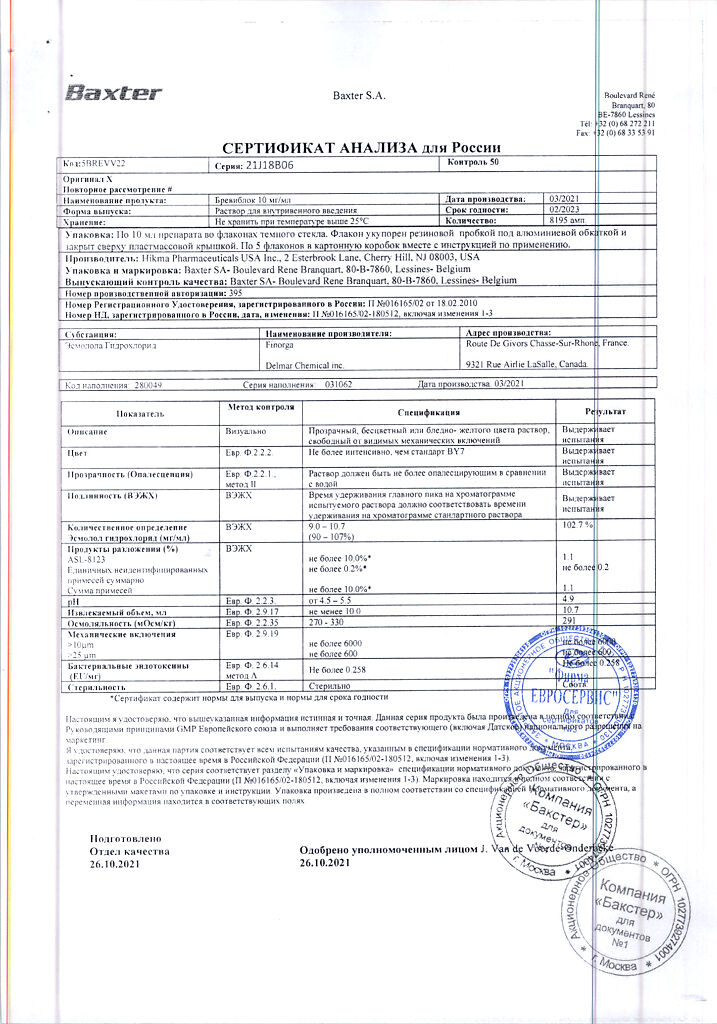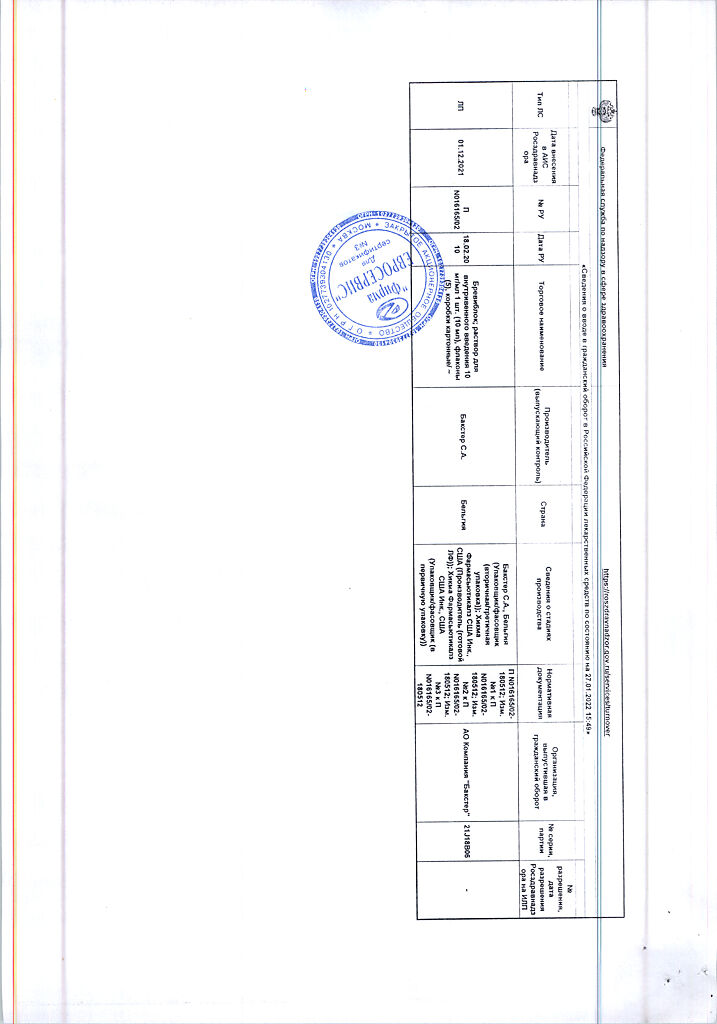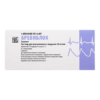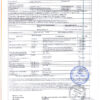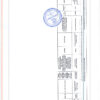No products in the cart.
Breviblock, 10 mg/ml 10 ml 5 pcs
€1.00
Out of stock
(E-mail when Stock is available)
Description
Esmolol is a cardioselective beta1-adrenoreceptor blocker with rapid onset of action, very short duration of action, in therapeutic doses having no sympathomimetic and membrane stabilizing activity of its own; it has antianginal, antihypertensive and antiarrhythmic effects.
Decreases catecholamine-stimulated formation of cyclic adenosine monophosphate from adenosine triphosphate, reduces intracellular calcium ion current, decreases heart rate (HR), slows conduction, reduces myocardial contractility.
The antiarrhythmic effect is determined by inhibition; conduction of impulses in antegrade and, to a lesser extent, in retrograde direction through the atrioventricular node and along accessory pathways.
The action occurs from the moment of infusion, the full therapeutic effect develops 2 min after infusion and ends 10-20 min after cessation of the infusion.
Esmololol by its chemical nature belongs to the class of phenoxypropanolamine beta-adrenoblockers. It has an enzymatically labile ester link, as a result of which it is rapidly metabolized and has a short plasma elimination half-life.
Esmolol, like other beta-adrenoblockers, has negative in-, chrono-, batmo- and dromotropic effects.
There were no differences in hemodynamic effects in patients older than 65 years compared to younger patients.
Indications
Indications
Arterial hypertension,
hypertensive crises of various etiologies,
sinus tachycardia,
supraventricular tachycardia and tachyarrhythmia (including atrial fibrillation and flutter, including during and after operations);
thyrotoxic crisis,
myocardial infarction,
pheochromocytoma,
unstable angina.
Pharmacological effect
Pharmacological effect
Esmolol is a cardioselective beta1-adrenergic receptor blocker with a rapid onset of action, a very short duration of action, and in therapeutic doses does not have its own sympathomimetic and membrane-stabilizing activity; has antianginal, antihypertensive and antiarrhythmic effects.
Reduces catecholamine-stimulated formation of cyclic adenosine monophosphate from adenosine triphosphate, reduces the intracellular current of calcium ions, reduces heart rate (HR), slows conduction, and reduces myocardial contractility.
The antiarrhythmic effect is determined by inhibition; conduction of impulses in antegrade and, to a lesser extent, in retrograde directions through the atrioventricular node and along additional pathways.
The action begins from the moment of administration, the full therapeutic effect develops 2 minutes after administration and ends 10-20 minutes after stopping the infusion.
Esmolol, by its chemical nature, belongs to the class of phenoxypropanolamine beta-blockers. It has an enzymatically labile ester unit, as a result of which it is rapidly metabolized and has a short half-life from blood plasma.
Esmolol, like other beta-blockers, has negative ino-, chrono-, batmo- and dromotropic effects.
In patients over 65 years of age, no differences in hemodynamic effects were observed compared with younger patients.
Special instructions
Special instructions
Breviblok is prescribed with caution to patients with bronchospastic diseases, diabetes mellitus, and impaired renal function.
Concentrations greater than 10 mg/mL should be avoided due to possible skin necrosis. Continue the infusion for more than 24 hours with caution (insufficient study experience).
Can be used 48 hours after discontinuation of verapamil and reserpine.
It is not recommended to use butterfly needles. Incompatible in the same syringe with 5% sodium bicarbonate solution.
Active ingredient
Active ingredient
Esmolol
Composition
Composition
1 ml of the drug contains:
active substance:
esmolol hydrochloride 10 mg;
excipients:
sodium chloride 5.9 mg,
sodium acetate trihydrate 2.8 mg,
glacial acetic acid 0.546 mg,
hydrochloric acid to pH 5.0,
sodium hydroxide to pH 5.0,
water for injections up to 1 ml.
Pregnancy
Pregnancy
The safety of Breviblok in pregnant women has not been studied.
Due to the lack of data on the possibility of Breviblok passing into breast milk, it is not recommended for use during breastfeeding.
Contraindications
Contraindications
– Hypersensitivity to the components of the drug;
– severe bradycardia (heart rate less than 50 beats/min);
– sick sinus syndrome;
– atrioventricular block II and III degrees;
– cardiogenic shock;
– severe arterial hypotension;
– acute heart failure;
– pulmonary hypertension;
– pheochromocytoma without simultaneous use of alpha-blockers;
– age up to 18 years;
– simultaneous intravenous administration of “slow” calcium channel blockers (verapamil, diltiazem).
With caution:
– Atrioventricular block of the first degree;
– bronchial asthma, chronic obstructive pulmonary disease;
– peripheral circulatory disorders (Raynaud’s syndrome, intermittent claudication);
– chronic heart failure;
– renal dysfunction;
– hyperkalemia;
– thyretoxicosis;
– psoriasis;
– myasthenia;
– Prinzmetal’s angina;
– hypovolemia;
– pheochromocytoma (with simultaneous use of alpha-blockers);
– old age;
– pregnancy;
– diabetes mellitus;
– secondary arterial hypertension (caused by vasoconstriction, during or after surgery, against the background of hypothermia).
Side Effects
Side Effects
From the nervous system and sensory organs: rarely – feeling of fatigue, drowsiness, confusion, headache, dizziness, speech and/or vision disorders, agitation.
From the cardiovascular system and blood (hematopoiesis, hemostasis): rarely – hypotension, signs of peripheral ischemia, bradycardia, palpitations, thrombophlebitis.
Other: rarely – chills, fever, dyspnea, bronchospasm, constipation, urinary retention, burning, induration or infiltration of the skin around the site of drug administration (with extravasation).
Interaction
Interaction
Increases the concentration of digoxin in the blood, enhances the hypotensive effect of inhalation anesthetics, prolongs the muscle relaxant effect of succinylcholine (1.5 times).
Morphine and warfarin increase blood concentrations.
Overdose
Overdose
Symptoms: hypotension, bradycardia, bronchospasm.
Treatment: for bradycardia – intravenous administration of atropine sulfate or isoproterenol, or glucagon; for arterial hypotension – intravenous administration of fluid and vasoconstrictors (epinephrine, norepinephrine, dopamine or dobutamine), for bronchospasm – isoproterenol or a xanthine derivative.
Storage conditions
Storage conditions
At a temperature not exceeding 25 °C (do not freeze)
Shelf life
Shelf life
2 years
Manufacturer
Manufacturer
Hikma Pharmaceuticals USA Inc., USA
Additional information
| Shelf life | 2 years |
|---|---|
| Conditions of storage | At a temperature not exceeding 25 °C (do not freeze) |
| Manufacturer | Hikma Pharmaceuticals USA Inc. |
| Medication form | solution |
| Brand | #Н/Д |
Related products
Buy Breviblock, 10 mg/ml 10 ml 5 pcs with delivery to USA, UK, Europe and over 120 other countries.


